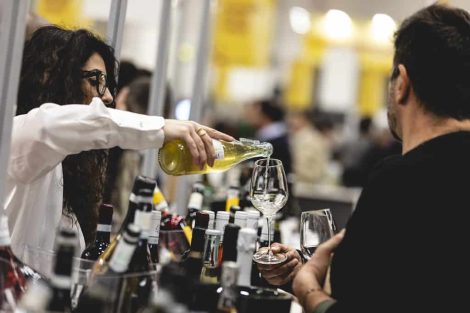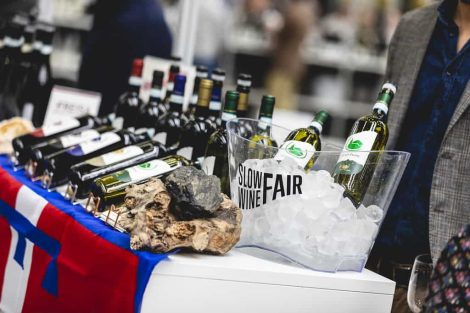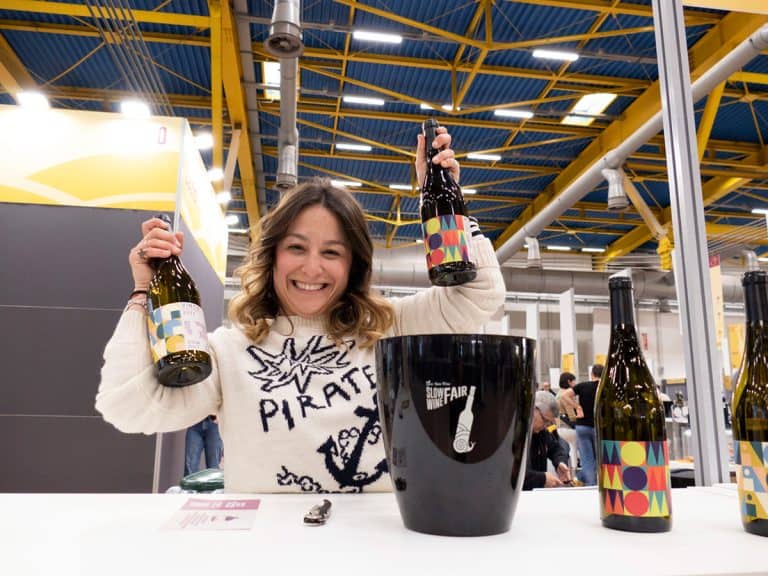The message is clear: the new approach to wine will also change all of agriculture. This is the essence of the third edition of Slow Wine Fair: a thousand exhibitors present, more than 300 more than last year, for a Wine List (as the organizers call it) of 3,576 labels to taste with joy. And the direction remains focused on a better, cleaner, and fairer horizon. The atmosphere in Bologna was joyful, full of vivacity and carefreeness. More than 12,000 entries were recorded, a real record. The moment is certainly not the best if we look at various factors concerning the world of wine, starting from exports, but perhaps, for this reason, a fair mostly aimed at enthusiasts and end consumers is what is needed right now. They are not alone, of course.
Organization, numbers, and wine
The organization has thought of everything, so here is also a large group of industry professionals ready to meet - through a dedicated platform - the many producers who have come to Bologna. Everything went smoothly from the first day. The attendance is one you don't complain about, tasting without too much crowding, and everything goes in the right direction, both for the attendees and for the producers.
Two dedicated pavilions and not just tasting counters (which, among other things, host companies from 27 different countries as well as from all over Italy): many masterclasses organized, on various themes, many of which are focused on topics that have always been dear to Slow, the Good, Clean, and Fair. The words of Giancarlo Gariglio, curator of the Slow Wine guide, make it clear about the direction of the fair and the organized meetings.
"The Slow Wine Fair is an ambitious fair with an important goal: to change the approach to agriculture through wine production. The almost one thousand companies that have exhibited their wines at the Slow Wine Fair have long made a specific choice, which goes in the direction of a drastic reduction in synthetic chemicals. Moreover, they use environmental resources consciously and sustainably, reflecting their terroir of origin, preserving biodiversity, and driving the social growth of their respective communities.
Over 50% of the companies present are certified organic or biodynamic and clearly indicate how to do profitable and sustainable agriculture, taking care of soil fertility, a key theme of this third edition. Healthy soil is, in fact, the essential basis of the economy, society, and the environment, as it produces food, increases our resilience to climate change, and promotes our well-being."

The 12 best wines tasted at Slow Wine Fair
Here are some wines that have left a lasting impression, not only for their sheer goodness but especially for their frankness, their way of conveying one or more varieties in a very specific territory. Sincere wines, therefore, with character to sell and their own precise identity. They are a dozen, but the list would be very, very long.
1. Barolo Montanello ’19 – Monchiero
A wine of great elegance despite its young age, the excellent vintage fills the glass with earthy notes, licorice, and underbrush, convincing the palate with acidic freshness, a present but well-integrated tannin, and a final savoriness that makes it deep, extremely refined, and vibrant.
2. Cerasauolo d’Abruzzo Baldovino ’23 - I Fauri
Valentina and Luigi Di Camillo will not produce Montepulciano d'Abruzzo in 2023, and that's how all the harvested grapes went into a more than delightful Cerasuolo. Body and structure are not lacking, but everything is perfectly balanced by the hard elements: a pinch of tannin to give rhythm, freshness is not lacking, but above all, a savory and satisfying finish that surprises. It's a preview, but we already see it as a wine to drink and re-drink, in summer as well as throughout the year.
3. Costa d’Amalfi Bianco Per Eva ’22 – Tenuta San Francesco
Delightful white from the Costa d'Amalfi produced by Tenuta San Francesco, which has already accustomed us to great Mediterranean-style wines, savory and satisfying. Per Eva is composed of three varieties, 40% falanghina and equal parts of ginestrella and pepella, both native. Scents of scrub, aromatic herbs, white flowers, and a floral touch precede a wide and very fresh palate, where acidity goes hand in hand with the salty part, giving a deep and satisfying sip together.
4. Derthona Timorasso Pitasso ’21 – Claudio Mariotto
A reference for Timorasso, Mariotto presents his whites starting from the historic cru Pitasso. Old Vines and natural selection allow only the best grapes to be brought into the cellar, expressing themselves in the glass with hints of candied lemon, broom, and yellow flowers, Mediterranean herbs, and a touch of helichrysum. The palate is wide, the volume is not lacking, but it is the sapid part that surprises for the taste and depth it manages to give.
5. Franciacorta Extra Brut Rosé – Barone Pizzini
A Franciacorta that comes from one of the cellars most attentive to sustainability and environmental protection. We really like this Rosé in Extra Brut version, obtained from 70% Pinot Noir and the remaining part of Chardonnay. Precise carbonic gives harmony to the sip, beautiful acidic freshness, and an incredible finish for finesse and elegance. The nose does the rest with the typical tones of wild strawberries of the red grape merging well with sensations of white flowers and pastry.
6. Grignolino d’Asti Arlandino ’22 – Tenuta Santa Caterina
We have long appreciated the wines of Santa Caterina, especially the Grignolino, of which we recommend some versions with a few years on them. In this case, however, try the young and lively version called Arlandino: berries and spices on the nose, a vinous touch on the palate, and away on the trail of a beautiful sapidity that alternates with acidic freshness. Truly delicious. Congratulations also for the work carried out by the company regarding the enhancement of soil fertility and the safeguarding of biodiversity.

7. Lambrusco di Sorbara Lambrusco del Fondatore ’22 – Tenimenti Cleto Chiarli
An absolute reference point when it comes to Lambrusco, the Chiarli family's company encompasses the flagship of its production, solely from its own vineyards, under the brand Tenimenti Cleto Chiarli. Lambrusco del Fondatore is a very pleasant Sorbara, distinguished by its acidity that gives freshness and elegance to the sip and is perfectly integrated with a juicy, smooth, and deep substance.
8. Ogliastra Rosso Case Sparse ’22 – Pusole
Lorenzo and Roberto Pusole work with passion and respect for the territory a few hectares of vineyards in Ogliastra. We are very close to the sea, and the grape of choice is Cannonau, which represents almost the entire blend of Case Sparse, a wine where also 10% of Monica, vinified with whole clusters, is used. The result is a wine of great freshness that gives clear Mediterranean aromatic hints, a smooth and juicy sip, and a savory, slightly peppery finish with notes of red fruits.
9. Spoleto Trebbiano Spoletino Anteprima Tonda ’21 – Antonelli San Marco
A winery that certainly needs no introduction, known for making the Montefalco area great through artisan wines, very well-made and with a strong identity. Apart from reds from Sagrantino and Sangiovese, there is a significant investment in Trebbiano Spoletino, from which this delightful white comes from a single vineyard. Highly dosed skin maceration and vinification in amphora for a wine that is not easily overlooked: with a touch of bitterness, scents of yellow fruit, and a slightly tannic palate, but never contracted, rather tasty and deep.
10. Toscana Tinto di Spagna ’21 – Antonio Camillo
We know and appreciate Antonio Camillo's reds made from Ciliegiolo grapes, but we have been literally enchanted by some wines made with Carignano and Grenache. Like the one we present, called by a synonym for the Grenache/Alicante/Cannonau grape, which surprises with scents of small red fruits, strawberry, and rose, but above all for a greedy and fragrant palate, where the mouth is wide, smooth, and juicy. Also try Granè (Carignano) and Mediterraneo (Ciliegiolo, Carignano, and Grenache).
11. Valtellina Superiore Il Pettirosso ’20 – Ar.Pe.Pe
Ae.Pe.Pe certainly needs no introduction, its wines are a certainty in Valtellina and throughout Italy. We tasted the Pettirosso ’20, the result of the two great areas of the region, Grumello and Sassella. 50-year-old vines, pure Chiavennasca, for a stunning result, where elegance reigns supreme, marked by notes of underbrush on the nose and a thin, fine, almost austere mouth, but never unfriendly.
12. Vigneti delle Dolomiti Nosiola ’18 – Salvetta
A small, very small production for the Nosiola signed by Salvetta, which comes from the heart of the production of this variety, the beautiful Valle dei Laghi. The 2018 literally drove us crazy, but we had the opportunity to do a small vertical from 2017 to 2021, and the results are convincing on all fronts. The standout was the 2018, 6 years after the harvest, the olfactory and gustatory freshness is amazing, and the wine is a triumph of complexity, combined with an unparalleled elegance. Definitely worth a try."


 US tariffs: here are the Italian wines most at risk, from Pinot Grigio to Chianti Classico
US tariffs: here are the Italian wines most at risk, from Pinot Grigio to Chianti Classico "With U.S. tariffs, buffalo mozzarella will cost almost double. We're ruined." The outburst of an Italian chef in Miami
"With U.S. tariffs, buffalo mozzarella will cost almost double. We're ruined." The outburst of an Italian chef in Miami "With US tariffs, extremely high risk for Italian wine: strike deals with buyers immediately to absorb extra costs." UIV’s proposal
"With US tariffs, extremely high risk for Italian wine: strike deals with buyers immediately to absorb extra costs." UIV’s proposal Meloni: "Tariffs? If necessary, there will be consequences. Heavy impact on agri-food sector"
Meloni: "Tariffs? If necessary, there will be consequences. Heavy impact on agri-food sector" The Government honours the greats of Italian cuisine, from Bottura to Pepe. Massari: "Thank you, Meloni, the only one who listened to us"
The Government honours the greats of Italian cuisine, from Bottura to Pepe. Massari: "Thank you, Meloni, the only one who listened to us"






